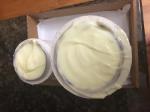Super-fatting Hot Process Soap
by Tamika
I want to super fat my batch of soap but don't know how much extra oil to use. Am making 1Lb of soap now as a test batch.
I know I can discount it on the Lye calc but I prefer to do it after the cooking process.
Am doing 6% now but it's calculated already in the recipe. How much is 6%?
Answer:
I've never added after the cooking process...only at a light trace or right from the start. Not sure what the result will be when it's added that late. I can advise for adding it at a light trace.
If your 1 pound recipe is already calculated with 6% more oil than is needed to saponify the sodium hydroxide, you can withhold approximately 1 oz. or 28 grams and add it to the soap once it reaches a light trace.
It really doesn't make any difference in the end if you add it at trace or right at the beginning since the lye will use up what it needs and leave the rest regardless.
Good luck,
Cathy
Comments for Super-fatting Hot Process Soap
|
||
|
||

